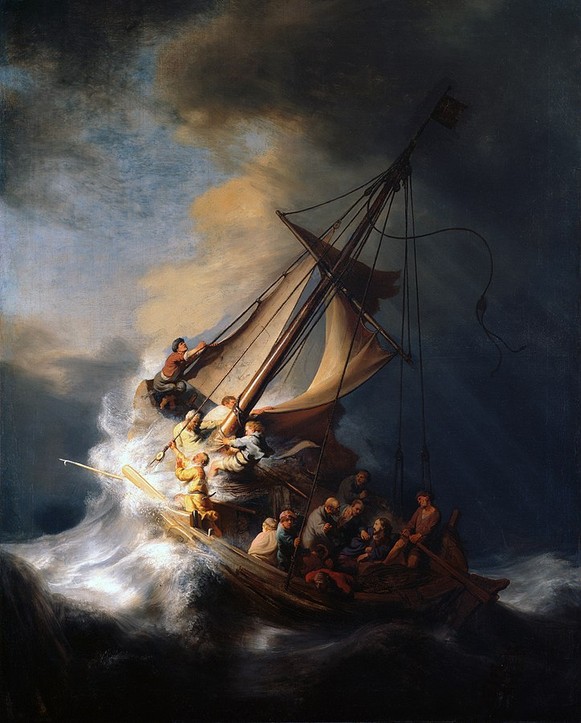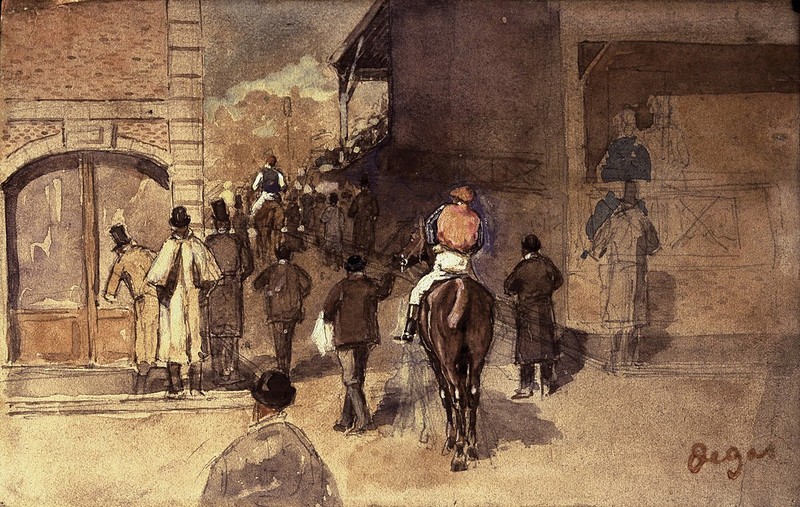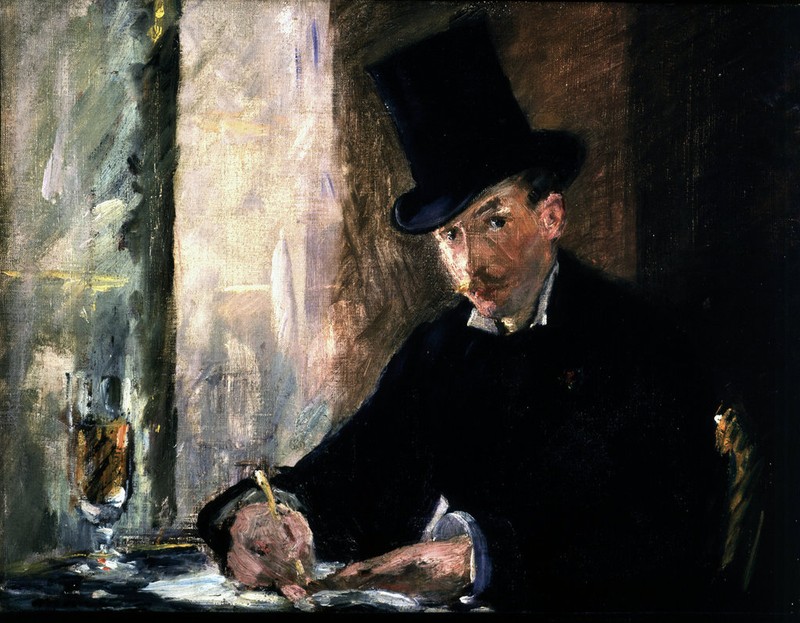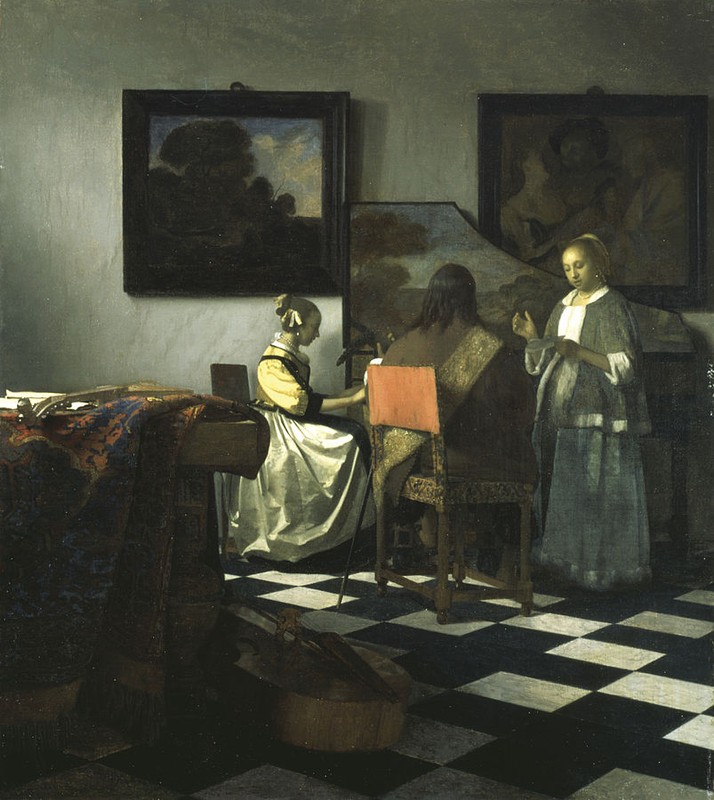Isabella Stewart Gardner Museum
Introduction
Text-to-speech Audio
Images
Isabella Stewart Gardner

The Isabella Stewart Gardner Museum opened in 1903.

The Storm on the Sea of Galilee (Rembrandt)

La Sortie de Pesage (Degas)

Chez Tortoni (Manet)

The Concert (Vermeer)

Backstory and Context
Text-to-speech Audio
Isabella Stewart Gardner was born in New York City on April 12, 1840 to David Stewart, a wealthy Irish linen tradesman and mining investor, and Adelia Smith. She was educated in New York and Paris and married her Paris school friend’s brother John “Jack” Lowell Gardner Jr. on April 10, 1860. The Gardner’s moved to Boston and in 1863, Gardner gave birth to a son, John L. Gardner III, who died 2 years later.
To try and cheer up his deeply depressed and ill wife, Jack took her to Europe where they traveled to many countries and Isabella developed her love for art. What started as simply purchasing pieces of art to decorate their home, traveling and art became the Gardner’s passion and they began amassing a beautiful and impressive art collection.
Isabella Gardner followed her parent's passion for art. Upon her father's passing, she acquired a substantial inheritance with which she used to purchase her first painting, "The Concert" by Vermeer, in 1892. In 1894, she became the first American to own a Renaissance-period painting (a Botticelli). In 1898, Gardner purchased a piece of land, and in 1899, construction on Fenway Court (the original name of the museum) began. The museum opened to the public on January 1st, 1903. A few years after suffering a series of strokes, Isabella Stewart Gardner passed away in 1924 and left $1 million dollars to the museum, as well as additional money to several other charities. Gardner stipulated in her will that could never be moved, and items could not be removed or added to the collection.
The Isabella Stewart Gardner Museum’s theft was the largest art heist in history, and it remains unsolved to this day. The theft, valued somewhere between $200 Million and $500 Million has resulted in widespread curiosity and speculation, since none of the paintings or artifacts have ever resurfaced, despite a widespread and continuous search, and a $10 Million reward.
The theft occurred in March 18, 1990, over St. Patrick’s Day Weekend, with the thieves making off with 13 pieces of art. The robbers assaulted the museum guards after posing as Boston Police Officers in order to gain access to the museum. They bound the guards with duct-tape and handcuffed them in the basement, disarmed the security cameras, and then proceeded to spend two hours robbing the museum, cutting the paintings out of their frames. Many art experts have despaired over the method of the theft, believing that the paintings would have been damaged by the crude cutting method.
The Museum has left their empty frames in place, symbolizing the mourning for the cultural artifacts, and their determination that one day, the objects will be recovered.
The paintings stolen include three paintings by Rembrandt—Storm on the Sea of Galilea, A Lady and Gentleman in Black, and a self-portrait— as well as Vermeer’s The Concert, five sketches by Degas, a portrait by Manet, Flinck’s Landscape with an Obelisk, a Chinese bronze vessel, and an eagle that once topped a Napoleonic era flag.
The statute of limitations ran out on the thefts in 1998.
As a result of the thefts, the Gardner Museum has increased security, insured their collections (the paintings stolen were notably not insured at the time of the robbery), installed climate control measurements, and increased fundraising activity. They also saw increased visitation and press as a result of the robberies.
Many people have been suspects or person of interests in the case, including members of the Irish Republican Army, James “Whitey” Bulger, a Boston crime boss and FBI informant, and Myles Connor Jr., who claimed the title of New England’s top art thief.
The stolen artworks from the Gardner Museum have been featured in a variety of films, books, TV shows, and podcasts. The Simpsons shows The Concert in the possession of Mr. Burns, while Storm in the Sea of Galilea appears in The Blacklist and Venture Brothers. Steven Colbert facetiously claimed to be in possession of The Concert on the Colbert Report.
Sources
"An Unconventional Life." Isabella Stewart Gardner Museum. Accessed May 19, 2015. http://www.gardnermuseum.org/about/history_and_architecture/isabella_stewart_gardner
"By The Numbers." Wisconsin Lawyer, vol. 89, no. 5. 10 - 10. Published May 1st 2016. HeinOnline.
"Collection." Isabella Stewart Gardner Museum. Accessed May 19, 2015. http://www.gardnermuseum.org/about/history_and_architecture/historic_collection_and_architecture
Durney, Mark. "Understanding the Motivations behind Art Crime and the Effects of an Institution's Response," Journal of Art Crime 2 (2009): 83-86
Ebrahimi, Shima. "Art Theft: The Isabella Stewart Gardner Museum Heist & An Investigation into Title and Statute of Limitations." Journal of Art Crime, vol. 1. 61 - 64. Published March 1st 2009. HeinOnline.
Evans, Laura. "Making the Best of the Worst: How the Isabella Stewart Gardner Museum Turned Its Loss into Gain." Journal of Art Crime, vol. 14. 39 - 46. Published September 1st 2015. HeinOnline.
Fincham, Derek. "An Empty Frame: Thinking about Art Crime." Journal of Art Crime, vol. 1. 49 - 51. Published March 1st 2009.
Isabella Stewart Gardner, Full-length Portrait, Standing, Facing Left]. 1908. Library of Congress Prints and Photographs Division, Washington, D.C. 20540 USA. Library of Congress. Web. 19 May 2015.
Highsmith, Carol M. Isabella Stewart Gardner Museum, Boston, Massachusetts. 1980. Library of Congress Prints and Photographs Division, Washington, D.C. 20540 USA. Library of Congress. Web. 19 May 2015.
https://commons.wikimedia.org/wiki/File:Rembrandt_Christ_in_the_Storm_on_the_Lake_of_Galilee.jpg
https://commons.wikimedia.org/wiki/File:La_Sortie_de_Pesage_by_E_Degas.jpg
https://commons.wikimedia.org/wiki/File:%C3%89douard_Manet_Chez_Tortoni.jpg
https://commons.wikimedia.org/wiki/File:Vermeer_The_concert.JPG
